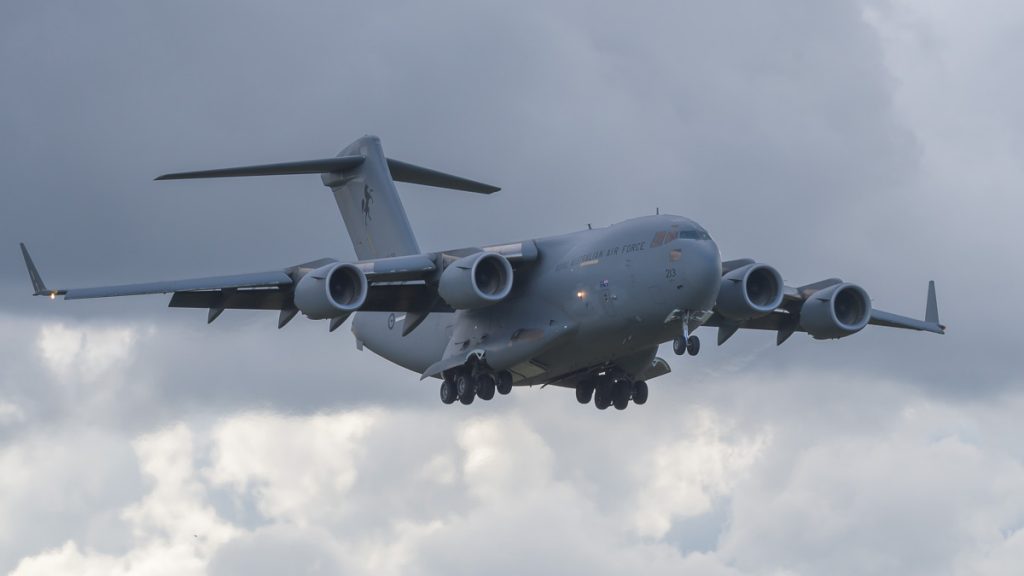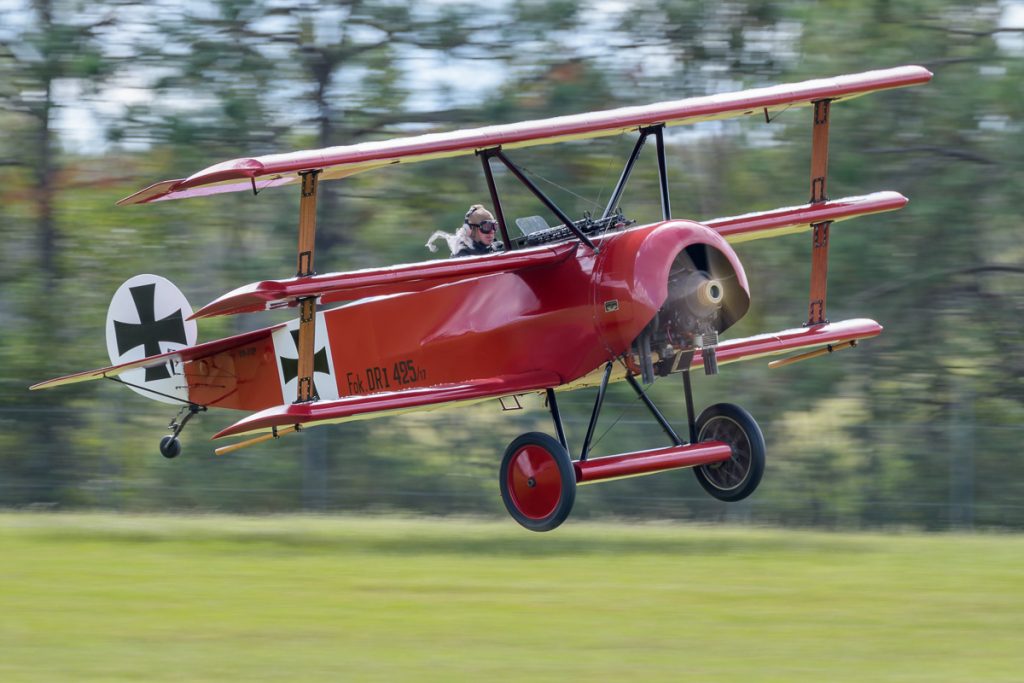This article showcases the currently-serving Royal Australian Air Force (RAAF) aircraft that performed displays at the TAVAS Great War Flying Display 2018 airshow. On the weekend of 21st and 22nd of April 2019 The Australian Vintage Aviation Society (TAVAS) staged an airshow event, primarily to remember the day 100 years ago when the Red Baron Manfred von Richthofen was shot down and killed by allied troops. In part five of a six-part series of articles covering the airshow, I will showcase the currently-serving RAAF aircraft that displayed at the airshow.
Boeing C-17A Globemaster III A41-213
The Boeing C-17 Globemaster III is a long haul, heavy lift transporter capable of carrying a 75,000Kg (165,000lb) payload. It is able to transport the Abrams M-1 main battle tank, and wheeled vehicles in side-by-side rows. It was designed to be capable of operating from relatively short, unpaved strips. It even has the ability to reverse using engine reverse thrust, including up a 2 degree slope.
Initially designed by McDonnell Douglas, manufacturing turned to Boeing when the companies merged in 1997. Maiden flight was in 1991, with initial delivery to USAF in 1993 after some development problems with wing structural failures in testing. A total of 267 units were produced before the line was closed in 2014, with 223 of these operated by the USAF. The type is currently operated by nine countries.
On the first pass she came in low, slow and dirty out of the threatening western sky. After passing the crowd they cleaned her up, applied power and banked around for a second pass. The second pass was clean, low and fast, again banking away to the north before climbing to return the short distance to RAAF Base Amberley.
To see a big aircraft like this coming in low and fast, then banking sharply and climbing steeply is something you have to see for yourself. Transport aircraft are meant to be slow, lumbering beasts, but this big girl is more like a sports car. I’ve witnessed these sort of low fast passes from RAAF C-17s several times since this airshow, and every time I think this just doesn’t look right. This is especially true when they practice for the annual Brisbane Riverfire festival, following the curves of the Brisbane River at 400ft then performing a power climb up over the Storey Bridge – just magnificent to witness from Eagle Street Pier or the footpath along the river.
In RAAF service, the C-17A is operated by No.36SQN who are based at RAAF Base Amberley, about 50Km west of Brisbane in Queensland, Australia. The aircraft provides the heavy airlift role for the RAAF, and regularly assists in disaster relief and humanitarian efforts especially around the South Pacific region. They are also used for supply missions to the Australian Antarctic division.
The squadron operates eight of the type, initially four aircraft were ordered and delivered in 2006-2008 with an additional four acquired in 2011, 2012, and 2015.
Boeing F/A-18F Super Hornet A44-221
The Boeing F/A-18 Super Hornet series consists of the single-seat F/A-18E operated by the US Navy, and F/A-18F two-seat variant currently operated by the USA, Kuwait and Australia with several countries considering purchase.
The type first flew in 1995, beginning service with US Navy in 2001 to replace their Grumman F-14 Tomcat fleet. At time of writing, over 600 of the type have been produced.
The Super Hornet is an upgrade from the F/A-18C/D model “legacy” Hornet, with upgraded engines each producing 35% more power, greater fuel capacity and endurance, extra underwing stores hardpoints and ability to return to carrier with greater unused fuel and munitions (called “bringback”). It also has improved AESA radar, avionics systems and lower radar cross-section than the legacy Hornet.
At the TAVAS airshow, the single Super Hornet came in low and hot from the West, for an initial runway beat-up run. They made a dirty pass (with undercarriage, flaps, arrestor hook and refuelling probe extended) then cleaned up and powered away. This was followed by several high-speed passes with rolls, tight turns and steep climbs with some afterburner, with many manoeuvres producing thick condensation sheets on the wing leading edges and wingtips.
After the airshow closed, I visited my sister who lives about 1Km West of the airfield. She was somewhat relieved to find out what it was that had shaken her house and scared the life out of her and her son earlier that day.
On the dirty pass, we even got a friendly wave from the weapons officer as the pilot rocked lazily the wings from side to side.
The RAAF operates a fleet of 24 F/A-18F Super Hornets, all by No.1SQN, based at RAAF Base Amberley, 50Km west of Brisbane in Queensland, Australia. They replaced the RAAF’s iconic and much-loved General Dynamics F-111 fleet, entering service in 2010 and reaching full operational capability in 2012. RAAF Super Hornets have participated in active bombing missions in Iraq, including strikes against the ISIL group.
For Australia, the aircraft performs the interceptor, air combat, land and sea strike and close air support roles for the RAAF, and will be phased out when the Lockheed Martin F-35A Lightning II fleet is up to full operational status. RAAF operates the two-seat F/A-18F version, which teams a pilot and Air Combat Officer to carry out their missions.
The RAAF weapon inventory for the Super Hornet includes the following ordnance:
- Conventional and Laser-Guided Bombs
- AIM-9X “Sidewinder” Short Range Air-to-Air Missile
- AIM-120 Advanced Medium Range Air-to-Air Missile (AMRAAM)
- AGM-154 Joint Stand-Off Weapon (JSOW)
- AGM-84 Harpoon Anti-Ship Missile
- Joint Direct Attack Munition (JDAM)
- Internal 20 mm M61 rotary cannon
Aircrew from 1SQN inspect the Fokker Triplane
At the end of the Red Baron’s final flight remembrance display, aircrew from RAAF No.1 SQN who were on the ground to control the RAAF displays took the opportunity to check out the latest in World War 1 engineering. It was smiles all round as the men who fly our supersonic 4th generation fighters squeezed into the cramped cockpit of the timber and fabric wonder from 100 years before.
Other Information
Location
The TAVAS museum is located at Caboolture Aerodrome, around 50Km north of Brisbane, Queensland, Australia. For more information on their collection of World War 1 replica aircraft, visit the TAVAS museum website.
Image Galleries
If you’d like to view more of images on this topic, below are some links to my photography gallery website.


























